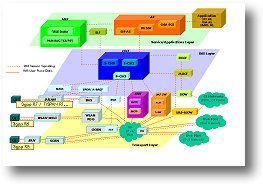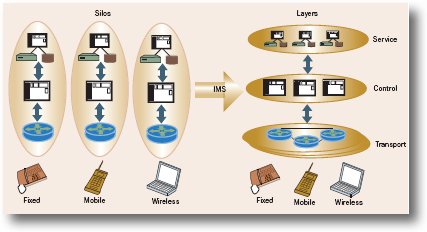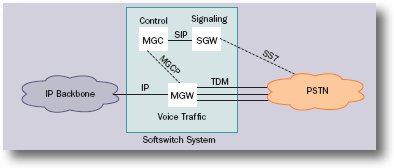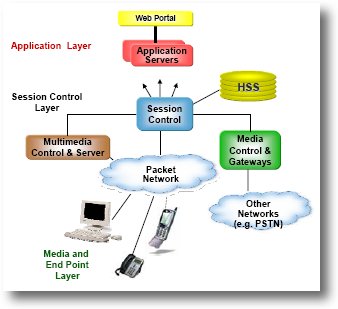IP Multimedia Subsystem or bust!
May 2007
 I have never felt so uncomfortable about writing
about a subject as I am now while contemplating IP Multimedia Subsystem (IMS). Why this should be I'm not quite sure.
I have never felt so uncomfortable about writing
about a subject as I am now while contemplating IP Multimedia Subsystem (IMS). Why this should be I'm not quite sure.
Maybe it's because one of the thoughts it triggers is the subject of Intelligent Networks (IN) that I wrote about many years ago - The Magic of Intelligent Networks. I wrote at the time:
"Looking at Intelligent Networks from an Information Technology (IT) perspective can simplify the understanding of IN concepts. Telecommunications standards bodies such as CCITT and ETSI have created a lot of acronyms which can sometimes obfuscate what in reality is straightforward."
This was an initiative to bring computers and software to the world voice switches that would enable carriers to develop advanced consumer services on their voice switches and SS7 signalling networks. To quote an old article:
"Because IN systems can interface seamlessly between the worlds of information technology and telecommunications equipment, they open the door to a wide range of new, value added services which can be sold as add-ons to basic voice service. Many operators are already offering a wide range of IN-based services such as non-geographic numbers (for example, freephone services) and switch-based features like call barring, call forwarding, caller ID, and complex call re-routing that redirects calls to user-defined locations."
Now there was absolutely nothing wrong with that vision and the core technology was relatively straightforward (database lookup number translation). The problem in my eyes was that it was presented as a grand take-over-the-world strategy and a be-all-and-and-all vision when in reality it was a relatively simple idea. I wouldn't say IN died a death, it just fizzled out. It didn't really disappear as such, as most of the IN related concepts became reality over time as computing and telephony started to merge. I would say it morphed into IP telephony.
Moreover, what lay at the heart of IN was the view that intelligence should be based in the network, not in applications or customer equipment. The argument about dumb networks versus Intelligent networks goes right back to the early 1990s and is still raging today - well at least simmering.
Put bluntly, carriers laudably want intelligence to be based in the network so they are able to provide, manage and control applications and derive revenue that will compensate for plummeting Plain Old Telephony Services (POTS) services. Whereas most IT and Internet people do not share this vision as they believe it holds back service innovation which generally comes from small companies. There is a certain amount of truth in this view as there are clear examples of where this is happening today if we look at the fixed and mobile industries.
Maybe I feel uncomfortable with the concept of IMS as it looks like the grandchild of IN. It certainly seems to suffer from the same strengths and weaknesses that affected its progenitor. Or, maybe it's because I do not understand it well enough?
What is IP Multimedia Subsystem (IMS)?
IMS is an architectural framework or reference architecture - not a standard - that provides a common method for IP multiple media ( I prefer this term to multimedia) services to be delivered over existing terrestrial or wireless networks. In the IT world - and the communications world come to that - a good part of this activity could be encompassed using the term middleware. Middleware is an interface (abstraction) layer that sits between the networks and applications / services that provides a common Application Programming Interface (API).
The commercial justification of IMS is to enable the development of advanced multimedia applications whose revenue would compensate for dropping telephony revenues and the reduce customer churn.
The technical vision of IMS is about delivering seamless services where customers are able to access any type of service, from any device they want to use, with single sign-on, with common contacts and fluidity between wire line and wireless services. IMS has ambitions about delivering:
-
Common user interfaces for any service
-
Open application server architecture to enable a 'rich' service set
-
Separate user data from services for cross service access
-
Standardised session control
-
Inherent service mobility
-
Network independence
-
Inter-working with legacy IN applications
One of the comments I came across on the Internet from a major telecomms equipment vendor was that IMS was about the "Need to create better end-user experience than free-riding Skype, Ebay, Vonage, etc.". This, in my opinion, is an ambition too far as innovative services such as those mentioned generally do not come out of the carrier world.
Traditionally each application or service offered by carriers sit alone in their own silos calling on all the resources they need, using proprietary signalling protocols, and running in complete isolation to other services each of which sit in their own silo. In many ways this reflects the same situation that provided the motivation to develop a common control plane for data services called GMPLS. Vertical service silos will be replaced with horizontal service, control and transport layers.

Removal of service silos
Source: Business Communications Review, May 2006
As with GMPLS, most large equipment vendors are committed to IMS and supply IMS compliant products. As stated in the above article:
"Many vendors and carriers now tout IMS as the single most significant technology change of the decade... IMS promises to accelerate convergence in many dimensions (technical, business-model, vendor and access network) and make �anything over IP and IP over everything� a reality.
Maybe a more realistic view is that IMS is just an upgrade to the softswitch VoIP architecture outlined in the 90s - albeit being a trifle more complex. This is the view of Bob Bellman, in an article entitled From Softswitching To IMS: Are We There Yet? Many of the core elements of a softswitch architecture are to be found in the IMS architecture including the separation of the control and data planes.

VoIP SoftSwitch Architecture
Source: Business Communications Review,
April 2006
Another associated reference architecture that is aligned with IMS and is being popularly pushed by software and equipment vendors in the enterprise world is Service Oriented Architecture (SOA) an architecture that focuses on services as the core design principle.
IMS has been developed by an industry consortium and originated in the mobile world in an attempt to define an infrastructure that could be used to standardise the delivery of new UMTS or 3G services. The original work was driven by 3GPP2 and TISPAN. Nowadays, just about every standards body seems to be involved including Open Mobile Alliance, ANSI, ITU, IETF, Parlay Group and Liberty Alliance - fourteen in total.
Like all new initiatives, IMS has developed its own mega-set of of T/F/FLAs (Three, four and five letter acronyms) which makes getting to grips with the architectural elements hard going without a glossary. I won't go into this much here as there are much better Internet resources available: The reference architecture focuses on a three layer model:
#1 Applications layer:
The application layer contains Application Servers (AS) which host each individual service. Each AS communicated to the control plane using Session Initiation Protocol (SIP). Like GSM, an AS can interrogate a database of users to check authorisation. The database is called the Home Subscriber Server (HSS) or an HSS in a 3rd party network if the user is roaming 9In GSM this is called the Home Location Register (HLR).

(Source: Lucent Technologies)
The application layer also contains Media Servers for storing and playing announcements and other generic applications not delivered by individual ASs, such as media conversion.
Breakout Gateways provide routing information based on telephone number looks-ups for services accessing a PSTN. This is similar functionality to that was found in IN systems discussed earlier.
PSTN gateways are used to interface to PSTN networks and include signalling and media gateways.
#2 Control layer:
The control plane hosts the HSS which is the master database of user identities and the individual calls or service sessions currently being used by each user. There are several roles that a SIP call / session controller can undertake:
-
P-CSCF (Proxy-CSCF) This provides similar functionality as a proxy server in an Intranet
-
S-CSCF (Serving-CSCF) This is the core SIP server always located in the home node
-
I-CSCF (Interrogating-CSCF) This is a SIP server located at a network's edge and it's address can be found in DNS servers by 3rd party SIP servers.
#3 Transport layer:
IMS encompasses any services that uses IP / MPLS as transport and pretty much all of the fixed and mobile access technologies including ADSL, cable modem DOCSIS, Ethernet, Wi-Fi, WIMAX and CDMA wireless. It has little choice in this matter as if IMS is to be used it needs to incorporate all of the currently deployed access technologies. Interestingly, as we saw in the DOCSIS post - The tale of DOCSIS and cable operators, IMS is also focusing on the of IPv6 with IPv4 'only' being supported in the near term.
Roundup
IMS represents a tremendous amount of work spread over six years and uses as many existing standards as possible such as SIP and Parlay. IMS is work in progress and much still needs to be done - security and seamless inter-working of services are but two.
All the major telecommunications software, middleware and integrators are involved and just thinking about the scale of the task needed to put in place common control for a whole raft of services makes me wonder about just how practical the implementation of IMS actually is? Don't take me wrong, I am a real supporter of the these initiatives because it is hard to come up with an alternative vision that makes sense, but boy I'm glad that I'm not in charge of a carrier IMS project!
The upsides of using IMS in the long term are pretty clear and focus around lowering costs, quicker time to market, integration of services and, hopefully, single log-in.
It's some of the downsides that particularly concern me:
-
Non-migration of existing services: Like we saw in the early days of 3G, there are many services that would need to come under the umbrella of an IMS infrastructure such as instant conferencing, messaging, gaming, personal information management, presence, location based services, IP Centrex, voice self-service, IPTV, VoIP and many more. But, in reality, how do you commercially justify migrating existing services in the short term onto a brand new infrastructure - especially when that infrastructure is based on a non-completed reference architecture?
IMS is a long term project that will be redefined many times as technology changes over the years. It is clearly an architecture that represents a vision for the future that can be used to guide and converge new developments but it will many years before carriers are running seamless IMS based services - if they ever will.
-
Single vendor lock-in: As with all complicated software systems, most IMS implementations will be dominated by a single equipment supplier or integrator. �Because vendors won�t cut up the IMS architecture the same way, multi-vendor solutions won�t happen, Moreover, that single supplier is likely to be an incumbent vendor." This was quoted by Keith Nissen from InStat in a BCR article.
-
No launch delays: No product manager would delay the launch of a new service on the promise of jam tomorrow. While the IMS architecture is incomplete, services will continue to be rolled out without IMS further inflaming the Non-migration of existing services issue raised above.
-
Too ambitious: Is the vision of IMS just too ambitious? Integration of nearly every aspect of service delivery will be a challenge and a half for any carrier to undertake. It could be argued that while IT staff are internally focused getting IMS integration sorted they should be working on externally focused services. Without these services, customers will churn no matter how elegant a carrier's internal architecture may be. Is IMS, Intelligent Networks reborn to suffer the same fate?
-
OSS integration: Any IMS system will need to integrate with carrier's often proprietary OSS systems. This compounds the challenge of implementing even a limited IMS trial.
-
Source of innovation: It is often said that carriers are not the breeding ground of new, innovative services. This lies with small companies on the Internet creating Web 2.0 services that utilise such technologies as presence, VoIP and AJAX today. Will any of these companies care whether a carrier has an IMS infrastructure in place?
-
Closed shops - another walled garden?: How easy will it be for external companies to come up with a good idea for a new service and be able to integrate with a particular carrier's semi-proprietary IMS infrastructure?
-
Money sink: Large integration projects like IMS often develop a life of their own once started and can often absorb vast amounts of money that could be better spent elsewhere.
I said at the beginning of the post that I felt uncomfortable about writing about IMS and now that I'm finished I am even more uncomfortable. I like the vision - how could I not? It's just that I have to question how useful it will be at the end of the day and does it divert effort, money and limited resource away from where they should be applied - on creating interesting services and gaining market share. Only time will tell.
Addendum: In a previous post, I wrote about the IETF's Path Computation Element Working Group and it was interesting to come across a discussion about IMS's Resource and Admission Control Function (RACF) which seems to define a 'similar' function. The RACF includes a Policy Decision capability and a Transport Resource Control capability. A discussion can be found here starting at slide 10. Does RACF compete with PCE or could PCE be a part of RACF?
